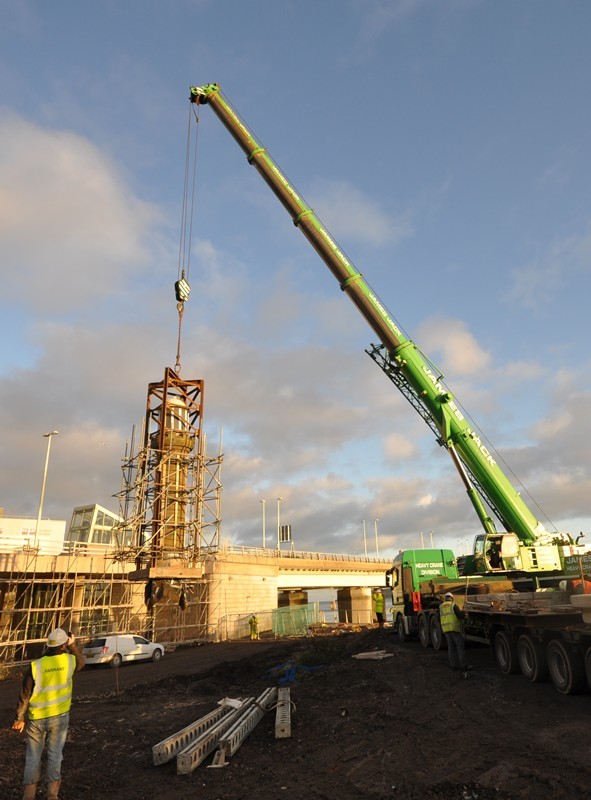It is an enduring reminder of Dundee’s great seafaring past but, up until recently, the Telford Beacon was almost completely hidden among shrubbery and an exit ramp from the Tay Road Bridge. But due to renovation work to make way for the transformation of the city’s waterfront, it now has a new home, as Jennifer Cosgrove discovered.
Constructed in the 1830s when Dundee’s dockyards were still taking shape, beacons served an important purpose, guiding ships to safety by shining different coloured lights across the dark waters of the Tay.
Although named after the famed civil engineer Thomas Telford, who designed the city’s King William IV Dock, the remaining 12ft stone structure was actually built by James Leslie, appointed as Dundee’s harbour engineer in 1832. Leslie was responsible for the expansion of the dock area, including Camperdown Dock, Victoria Dock and also for the Custom House and Harbour Chambers.
The beacons functioned for over 100 years their window frames filled with tinted glass, originally powered by whale oil and, later, by electricity before they were eventually declared redundant in the 1960s and the harbour filled in to make way for the Tay Road Bridge.
The beacon, originally situated on the wall that separated King William IV Dock from the tidal harbour, was retained as a monument to the past, eventually becoming landlocked by concrete bridge ramps and trees. It survived there, close to what we now know as the north down-ramp of the road bridge, near the Hilton Hotel, for over 170 years.
Now a category-B listed building, the beacon has been surrounded by a construction site since last May due to bridge ramp replacement work under way as part of a massive project to transform Dundee’s waterfront.
The north ramp was taken down in October and a new one is due to be constructed this year in much the same position, only at a tighter radius. This work made it necessary for the beacon to be ferried to a new location by the Tay.
Ensuring it was moved safely was a long process that involved Dundee City Council consulting with Historic Scotland. Weeks of investigating the soundness of the structure as well as the best way to transport it around 100 metres south to the sea wall culminated in the big flit, which took place on November 23.
The council’s engineering company devised the plan and then employed civil engineering contractor Farrans to carry out the all-important move. It was lifted from its original spot just far enough to allow a new concrete base to be cast underneath. This new base had lifting points which meant the base and beacon could be raised on to the back of a lorry by crane. The beacon was also braced to make sure it remained rigid.
It appears to have withstood the elements well, having been refurbished last in 2004 when the glass panels, broken by vandals, were replaced by timber and the dome renovated under specifications laid down by Historic Scotland.
John Gray, planning officer for Dundee City Council, set up a camera on Tayside House to document the beacon’s journey producing the striking timelapse video above.
He said, “When it was announced the beacon would be moved, a lot of people expressed an interest in what was going to happen to it and many noticed it was missing and began asking about it.”
City archivist Iain Flett said it was wonderful this piece of Dundee’s seafaring past had been retained.
“The harbour commissioners were set up in 1815 to put Dundee’s harbour on a modern footing and they got Telford the best engineer to come and do it. If you look at the Craigellachie Bridge on the River Spey or the Caledonian Canal, you see these little castle-like structures, so I think the beacon is in memory of Telford.
“Admiralty charts for seafarers would have red lights, green lights, fixed lights or flashing lights. This beacon had a red light to give an indication of where the dock gates were at night.
“Originally, in the 1830s, the light would have been powered by whale oil because there was a huge industry for this at the time. Even then there were oil booms and if whaling was bad in the Arctic which frequently it was the price of oil would double and you would have entrepreneurs who would buy up all the quantities to sell, so things haven’t changed at all.”
Mr Flett says there were numerous beacons, including a series on Craig Pier (now Discovery Point) where the Fifie ferries would dock.
“This was a full-time job for someone to ensure they were all lit and very important at the time,” he said. “I wonder how many people remember coming across the Tay into Craig Pier on a dark winter’s night and seeing the harbour lights?”
By the 1930s the docks were becoming surplus to requirements and the Earl Grey Dock was filled in. King William IV Dock was used by submarines in the second world war and small boats would have been using it right up until the 1960s, so the beacon would have been a working light right up until they filled in the dock to build the Tay Road Bridge.
“I think people will appreciate where it is now because it looks more logical at the waterfront,” Mr Flett added.
There is even a possibility the Telford Beacon may once again be lit up. As part of the move, electrical supplies were laid but no firm decision has been made.
